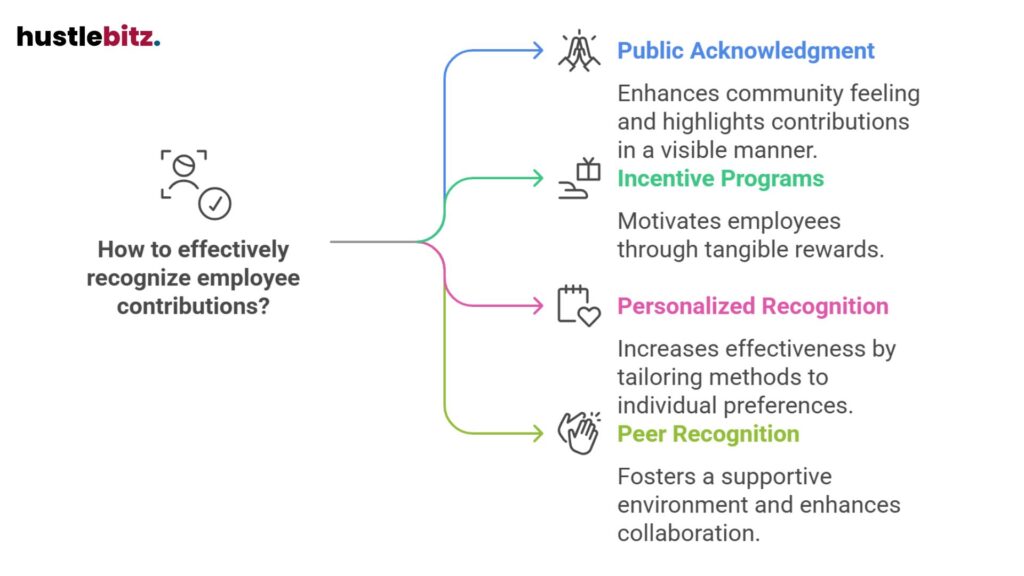To boost employee productivity in the office, consider implementing flexible work hours to enhance satisfaction. A positive work environment fosters collaboration and creativity. Structured practices, such as regular breaks and minimizing distractions, help maintain focus. Encourage open communication and set clear goals to align efforts. Utilize productivity tools for efficient workflow management. Recognizing and rewarding achievements boosts morale and motivation. Team collaboration encourages diverse ideas and strengthens relationships. By adopting these proven strategies, organizations can create a more productive workplace. Discover additional techniques to further enhance productivity in your office.
Key Takeaways
- Implement flexible work arrangements to enhance job satisfaction and align schedules with peak performance times.
- Foster a positive work environment by minimizing distractions and promoting team collaboration, boosting engagement and creativity.
- Set clear goals using SMART criteria and involve employees in the goal-setting process to enhance ownership and productivity.
- Provide development opportunities through training, mentorship, and clear career paths to nurture skills and reduce turnover.
- Recognize and reward achievements to boost morale and motivate exceptional performance among employees.

1. Encourage Flexible Work Hours

Encouraging flexible work hours can significantly enhance employee productivity by allowing individuals to tailor their schedules according to their peak performance times. This adaptability fosters an environment where employees feel empowered to manage their work hours, directly contributing to increased workplace productivity. When employees can choose when they work, they are more likely to engage in tasks during their most productive hours, which can lead to higher quality outputs.
Flexible work arrangements also play a vital role in employee engagement. When individuals have the autonomy to structure their work schedules, they often experience greater job satisfaction. This satisfaction can translate into a more committed workforce, directly impacting employee retention rates. Companies that offer flexible work options demonstrate a commitment to their employees’ well-being, which can cultivate loyalty and reduce turnover.
Moreover, the modern work landscape has shifted, with many employees seeking a healthy work-life balance. By accommodating flexible work hours, organizations can attract a diverse talent pool, enhancing their competitive edge. This flexibility not only addresses the needs of individual employees but also aligns with broader organizational goals, creating a win-win scenario.
2. Create a Positive Work Environment

Creating a positive work environment is a natural progression from implementing flexible work hours, as both strategies contribute to enhancing employee satisfaction and productivity. A supportive atmosphere fosters collaboration, creativity, and a sense of belonging, all of which are crucial for improving employee engagement. When employees feel valued and respected, their commitment to the organization increases, directly impacting overall employee productivity.
To create a positive work environment, companies should prioritize open communication and transparency. This encourages employees to voice their ideas and concerns, which can lead to innovative solutions and increased workplace efficiency. Regular team-building activities and recognition programs can further strengthen relationships among colleagues, promoting a culture of support and camaraderie.
Additionally, physical workspace design plays a significant role in shaping the work environment. Incorporating elements such as natural light, comfortable furniture, and designated collaborative spaces can positively influence how employees feel while at work. By ensuring that the workplace is not only functional but also aesthetically pleasing, organizations demonstrate their commitment to employee well-being.
Ultimately, creating a positive work environment is about understanding the needs and preferences of employees. When organizations actively work to cultivate a supportive culture, they not only improve employee engagement but also lay the groundwork for sustained productivity and success. By prioritizing these factors, businesses can create a thriving atmosphere where employees feel motivated to perform at their best.
3. Implement Regular Breaks
Implementing regular breaks throughout the workday can significantly enhance employee focus and overall productivity. Research indicates that taking scheduled breaks allows employees to recharge mentally and physically, combating fatigue and maintaining high levels of engagement. In a fast-paced workplace environment, where distractions are prevalent, these breaks are crucial for sustaining attention and delivering quality work.
To effectively implement regular breaks, organizations can adopt strategies such as the Pomodoro Technique, which encourages short, timed intervals of work followed by brief pauses. This method not only helps employees to structure their tasks but also fosters a culture that values well-being and balance. Regular breaks provide opportunities for employees to step away from their desks, stretch, and refocus their thoughts, ultimately leading to a more energized workforce.
Additionally, integrating social breaks into the daily routine can enhance team cohesion and morale. Encouraging employees to take breaks together fosters collaboration and communication, further contributing to a positive workplace environment. As employees engage in light conversations or participate in group activities, they often return to their tasks with renewed vigor and creativity.
4. Foster Open Communication

Regular breaks can serve as a foundation for fostering open communication within the workplace, as they provide employees with opportunities to engage in meaningful conversations and share ideas. When employees feel comfortable expressing their thoughts and opinions, it leads to a more collaborative work environment where innovative solutions can flourish.
To effectively foster open communication, organizations should prioritize creating an atmosphere where employee feedback is encouraged and valued. Regularly soliciting feedback not only demonstrates that management is attentive to employees’ needs but also empowers staff to contribute to the decision-making process. This, in turn, can significantly improve workplace productivity, as employees who feel heard are often more motivated and engaged in their tasks.
Moreover, an open communication culture enhances the overall employee experience. Employees should be able to approach their managers with concerns or suggestions without fear of negative repercussions. Establishing regular check-ins or informal gatherings can facilitate these dialogues, allowing employees to connect on both personal and professional levels.
Encouraging transparency in communication further strengthens trust among team members, leading to more effective collaboration. When employees share their thoughts freely, they are more likely to work together towards common goals, thereby enhancing productivity.
5. Set Clear Goals and Expectations

Setting clear goals and expectations is essential for guiding employees towards achieving their objectives and enhancing overall productivity in the workplace. When employees understand what is expected of them, they are more likely to focus their efforts on tasks that align with organizational goals, thereby increasing employee productivity.
To effectively set clear goals, it is crucial to ensure that they are Specific, Measurable, Achievable, Relevant, and Time-bound (SMART). This framework not only helps clarify objectives but also provides a tangible way to assess employee performance. By establishing measurable milestones, employees can track their progress and stay motivated as they work towards their goals.
Moreover, involving employees in the goal-setting process can significantly help improve their engagement and commitment. When individuals feel that their input is valued, they are more likely to take ownership of their responsibilities and strive for excellence.
Regular check-ins and feedback sessions can further reinforce expectations and allow for adjustments if needed, ensuring that employees remain aligned with their objectives.
6. Provide Opportunities for Development

In addition to establishing clear goals, providing opportunities for development is vital for fostering employee growth and enhancing overall productivity within the organization.
When employees feel that their skills are being nurtured, they are more engaged and motivated, which ultimately leads to increased employee productivity. This commitment to development not only empowers staff but also helps them adapt to the evolving demands of the workplace, especially in the context of remote work.
To effectively provide opportunities for development, organizations can consider the following strategies:
- Training Programs: Implement regular training sessions that focus on both hard and soft skills. This investment in education helps employees stay relevant in their roles.
- Mentorship Opportunities: Pairing less experienced employees with seasoned mentors can facilitate knowledge transfer and skill enhancement, fostering a culture of continuous learning.
- Career Pathing: Clearly outline potential career paths within the organization, allowing employees to visualize their future and set personal development goals.
- Feedback Mechanisms: Establish regular check-ins and feedback loops to help employees identify areas for improvement and celebrate their successes.

7. Utilize Productivity Tools

Utilizing productivity tools effectively can significantly enhance workflow efficiency and streamline communication within teams. By integrating the right tools, organizations can foster an environment conducive to collaboration and task management. These tools, ranging from project management software to communication platforms, can help employees stay organized, prioritize their tasks, and ultimately improve employee productivity.
To boost employee productivity, it is essential to select tools that align with the specific needs of the team. For instance, a project management tool like Asana or Trello can help teams visualize their workflow, set deadlines, and track progress, which enhances overall productivity at work. Additionally, communication tools such as Slack or Microsoft Teams facilitate real-time discussions, reducing the time spent on emails and meetings.
Moreover, regular training on these productivity tools can further enhance employee efficiency. When employees are well-versed in using these tools, they can navigate them seamlessly, minimizing disruptions and maximizing output.
It is also beneficial to encourage feedback on the tools being utilized, as this can lead to adjustments that better fit the team’s workflow.
8. Recognize and Reward Achievements

Acknowledging and rewarding employee achievements can significantly enhance motivation and reinforce a culture of productivity within the workplace.
Employee recognition not only boosts morale but also encourages individuals to consistently deliver quality work. By implementing effective recognition strategies, organizations can achieve remarkable improvements in employee productivity.
Here are four ways to improve employee productivity through recognition and rewards:
- Public Acknowledgment: Recognize achievements in team meetings or company newsletters. This not only highlights individual contributions but also fosters a sense of community.
- Incentive Programs: Develop formal reward programs that grant bonuses, gift cards, or extra time off for exceptional performance. Such incentives can motivate employees to strive for excellence.
- Personalized Recognition: Tailor recognition methods to fit individual preferences. Some may appreciate verbal praise, while others may prefer written notes or gifts. Understanding these preferences can increase the effectiveness of your recognition efforts.
- Peer Recognition: Encourage team members to recognize each other’s contributions. Implementing a peer-to-peer recognition program can create a supportive environment and enhance collaboration, ultimately increasing efficiency.

9. Promote Team Collaboration

Fostering team collaboration is essential for enhancing overall productivity, as it encourages diverse ideas and strengthens relationships among employees. When organizations promote team collaboration, they create an environment where individuals feel valued and empowered to contribute. This collaborative atmosphere not only boosts employee productivity but also fosters innovation, as team members share unique perspectives and skills.
To effectively promote team collaboration, it is crucial to implement tools and practices that facilitate communication and cooperation. Utilizing project management software, for example, can streamline workflows and enable teams to track progress collectively. Regular team meetings and brainstorming sessions can also encourage open dialogue, ensuring that all voices are heard and considered. Additionally, creating shared goals can align team members’ efforts and motivate them to work toward common objectives.
Moreover, when employees work smarter through collaboration, they can optimize their strengths and compensate for each other’s weaknesses. This synergy often leads to improved efficiency, allowing teams to accomplish tasks more rapidly and with higher quality outcomes.
Furthermore, a collaborative culture can enhance employee morale, leading to reduced turnover and absenteeism—factors that significantly impact workforce productivity.
10. Minimize Distractions in the Office
Minimizing distractions in the office is critical for maintaining employee focus and enhancing overall productivity. A well-structured workplace that prioritizes concentration can significantly increase productivity levels and boost employee morale.
To effectively minimize distractions in the office, consider implementing the following strategies:
- Designate Quiet Zones: Create specific areas in the office where employees can retreat for focused work. These zones should be free from noise and interruptions, allowing staff to concentrate fully.
- Encourage Use of Headphones: Allowing employees to use headphones can help them tune out ambient noise and minimize distractions. This small adjustment can foster an environment where individuals can better focus on their tasks.
- Implement Clear Communication Protocols: Establish guidelines for when and how to communicate during work hours. This will reduce unnecessary interruptions and help employees manage their time effectively.
- Limit Non-Essential Meetings: Excessive meetings can break concentration and disrupt workflow. Encourage teams to evaluate the necessity of meetings and consider alternatives, such as emails or instant messaging, to convey information.
Final Thoughts
Boosting employee productivity in the office requires a holistic approach that encompasses flexible work arrangements, a positive work environment, and the effective use of productivity tools. By implementing strategies such as regular breaks, clear goal-setting, and fostering team collaboration, organizations can create a workplace that supports both individual and collective success. Recognizing achievements and minimizing distractions further enhance focus and motivation, ensuring that employees are engaged and productive. Ultimately, these proven methods help build a dynamic, efficient, and satisfied workforce, driving the organization toward its goals. By consistently applying these strategies, you can foster a culture of productivity that benefits both employees and the organization as a whole.




